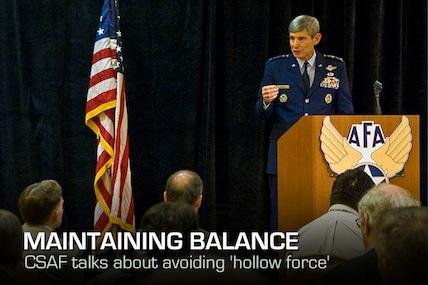The Air Force chief of staff reinforced the importance of avoiding a "hollow force" to a group of civic and industry leaders attending the Air Force Association's monthly breakfast in Arlington, Va., on June 11.
Gen. Norton Schwartz said the Air Force must secure the proper balance between three separate but closely related dimensions: readiness, modernization and force structure.
"A shortfall in one or more of these dimensions leads to insufficiencies that also are distinct but intertwined -- respectively: a hollow, aging, and poorly postured force," Schwartz said. "This complex interplay is why the oft-referenced 'delicate balance' is so difficult to achieve."
For the Air Force, an important part of achieving this balance is ensuring it has the right mix of active duty, Air National Guard and Air Force Reserve Airmen and force structure, Schwartz said.
To that end, Air Force leaders in all three components worked together on the fiscal 2013 budget request and related strategic planning to understand the compromises that can and must be made to maintain an effective, efficient force, he said.
"Despite the fact that we did not always agree with complete unanimity, which is understandable due to different perspectives and institutional imperatives between the active and reserve components, we stand by our consensus -- together," the general said.
The Air Force's plans to re-balance the force are needed in order to address the danger of unsustainable deployment rates by any one component, Schwartz said.
"Our reserve component is best optimized -- or, put another way, our reserve component affords us with the oft-referenced cost savings -- when Guard and Reserve Airmen are deployed at lower rates than their active-duty counterparts," the general said.
Therefore, the Air Force's current force structure needs to be re-optimized in relation to current realities and future eventualities, he said.
"Through careful, joint-sanctioned modeling, we determined that we could not sustain further active component cuts without jeopardizing the collective ability of the total force to support our nation's strategic interests," Schwartz said.
As the Air Force rebalances, it will leverage its total force integration efforts by increasing the number of associations between the active duty and Reserve components, thereby enhancing all aspects of mission readiness and effectiveness, he said.
"Our (total force integration) associations provide us with the ability to utilize highly experienced Reserve component Airmen in helping to accelerate the maturity of their active component counterparts quicker," Schwartz said, citing one example of how such associations benefit the force.
When these associations are operated properly, total force integration will create efficiencies for the Air Force, saving in operational and overhead costs across the board, the general said.
"Be assured that, as a total force, we are united in a common cause to provide more effective and efficient air power, including military support to domestic contingencies and civil authorities," Schwartz said.




























